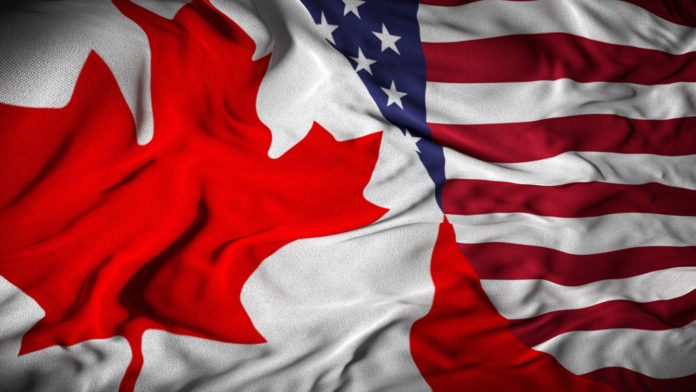
Canada is likely to keep its border with the United States closed to all but essential travel until the COVID-19 pandemic abates, which could be several more months.
“The situation surrounding the COVID-19 pandemic continues to rapidly evolve and we have been clear that our response will adapt in lock step,” a spokesperson for Canada’s public safety minister said Tuesday.
“Going forward, we will continue to evaluate the best public health information available to us to make a decision on when and how to reopen our border.”
While the Canada-U.S. border remains closed to all but essential travel, immigration to Canada from its neighbour to the south – its biggest trading partner – is taking a heavy hit.
Last year, 10,780 Americans chose to make Canada their permanent residence, with roughly half, 5,095 coming in the first half of 2019.
In the first six months of this year, that rate of new arrivals from the United States dropped by 24 per cent, to 3,870.
During the height of the lockdowns of the first wave of the pandemic in Canada, in April and May, only 695 Americans became new Canadian permanent residents, roughly a third of the number for the comparable months last year.
Now, it seems the Canada-U.S. border may remain closed for much longer than originally anticipated.
Last week, Blair reportedly suggested the Canada-U.S. border could stay close to all but essential travel for several more months. It is currently closed until October 21.
Read More
COVID-19 Immigration Restrictions Drive Canada’s Population Growth To Record Low
Impact of Coronavirus Crisis on Canada Immigration Laid Bare By Provincial Figures
Canada Rated No 1 in World For Welcoming Immigrants
Immigrants Help Boost Tech Companies’ Productivity: Study
The public safety minister reportedly said the border would remain closed “until the conditions on both sides of the border … change very substantively, until we can be assured based on the advice we receive from our public health officials.”
That advice would come from the country’s chief medical officer, Dr. Theresa Tam.
But if Tam already knows what she will recommend regarding the Canada-U.S. border, she is keeping it to herself. Neither she nor her staff commented on the possibility of re-opening the border during a press conference Tuesday.
The border closure has been extended on a monthly basis since it was imposed in March.
Blair said in a statement accompanying the September extension that: “The Government of Canada’s top priority remains the health and safety of Canadians, and this extension will continue to protect people on both sides of the border while ensuring the flow of essential goods and services between our two countries.”
Although the first wave of the COVID-19 pandemic seemed to abate in most regions of the country by July, cases have picked up again in the past few weeks.
The second wave – if that is what it is – started slowly. Then, the rate of new cases began to alarm public health officials.
By Monday this week, there had been 168,900 cases of COVID-19 infection in Canada with 17,122 of them still active.
The pandemic has claimed 9,504 lives in Canada, a death rate of 6.26 per cent of those diagnosed as having had the illness. The recovery rate has so far been slightly more than 93.7 per cent of diagnosed cases.
Outside of the three territories of the Yukon, Northwest Territories and Nunavut, the lowest number of COVID-19 deaths per province has been in Atlantic Canada. The small island province of Prince Edward Island had not had a single COVID-19 death as of Monday. New Brunswick had had two, Newfoundland and Labrador, four, and Nova Scotia 65.
The largest number of deaths have so far been in Canada’s provinces with the most densely-populated cities. In Quebec, the COVID-19 death toll stood at 5,884 on Monday. In Ontario, the deaths numbered 2,980.
The Canada-U.S. border closure is an attempt to slow the spread of the pandemic so that Canada’s healthcare system can manage it.
The border is closed for non-essential travel. Immigration, Refugees and Citizenship Canada (IRCC) has offered guidance on what constitutes essential and non-essential travel.
Reasons considered ‘non-essential’ include:
- To visit family for a vacation.
- For the birth of a grandchild, nephew, niece, cousin, etc. (For the parent of a child, this may be considered non-discretionary travel; however, it will still require assessment.)
- To spend time at a secondary residence (vacation home, hunting or fishing lodge, etc.). This includes entry for upkeep or maintenance purposes.
- To attend the funeral of a family member (This purpose of travel would be improbable due to quarantine measures and limits to the number of attendees at funerals under provincial restrictions.)
Reasons considered ‘essential’ include travel for:
- Economic services and supply chains.
- Critical infrastructure support.
- Health (immediate medical care), safety and security.
- Supporting Indigenous communities.
- Transiting through Canada for non-optional or non-discretionary purposes.
- Studying in Canada if already approved for a study permit on or before March 18.
- Tending to family matters for non-optional or non-discretionary purposes (such as bringing supplies to elderly parents or tending to sick family members) when there is no one else available in Canada to assist.
- Any other activities that are deemed non-optional or non-discretionary by the Government of Canada or based on an officer’s assessment.
14-Day Self-Quarantine Plan
Regardless of the reason for travel or exemption, any traveler with COVID-19 symptoms will not be allowed to enter Canada.
Furthermore, anyone entering Canada from the US or any other country will be required to self-quarantine for a period of 14 days upon entry.
Travelers are also required to present a quarantine plan, with details of where they will stay, how they will get groceries and medication and whether they will be staying with vulnerable people.

